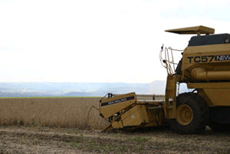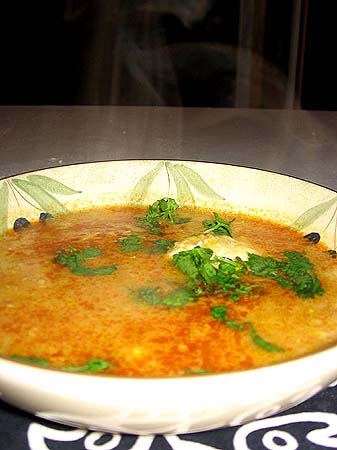 Yes, I know it's Monday. But I want to start working a food news roundup feature into the weekly routine and I'm a day behind. In the future, I hope to have this on Sunday when everyone can sit down with a cup of their favorite java and catch up on The Slow Cook.
Yes, I know it's Monday. But I want to start working a food news roundup feature into the weekly routine and I'm a day behind. In the future, I hope to have this on Sunday when everyone can sit down with a cup of their favorite java and catch up on The Slow Cook.If you are a regular reader of The Washington Post, my former employer, and if you ever make it over to the Business section, you might have seen a piece on April 24 about Greenpeace and McDonald's teaming up to try and slow deforestation of the Amazon rain forest in Brazil.
You might be asking yourself what in the world Greenpeace, McDonald's and Brazil have in common and the answer would be soy. Some farmers see all that rain forest as a waste and have been systematically chopping it down to grow commodity crops such as soy beans. The soy beans are then gobbled up by huge international food companies such as Cargill, which then sell them to huge food processors such as McDonald's as chicken feed. You know, for the McNuggets.
Originally, Greenpeace, which is trying to stop the chopping down of the rain forest, accused McDonalds of being complicit in the clearing of environmentally sensitive lands to farm soy beans. But as of January, the fast-food purveyor and the environmentalists were jointly pressuring Brazil's largest soy bean traders to place a two-year moratorium on purchasing any soy products from newly deforested areas.
Wait, it gets even better. This all started orginally with--can you guess?--genetically modified crops. Americans are using GMOs (as the genetically modified varieties are known) while Europeans are saying No Thank You. So some Brazilian farmers, with help from Cargill, started converting interior parts of the rain forest to soy production aimed at the European market for unadulterated soy.
The huge scale of the operation started to reveal itself on satellite images, spurring Greenpeace to act. Greenpeace combed records to see which companies were involved in the new soy production and who was buying it. McDonald's name came up as a buyer for its European operations.
Then Greenpeace fingered Cargill, which had built a special port in Brazil for shipping the soy but claimed it was only giving a leg up to impoverished farmers.
But then there was a meeting of the minds, with McDonald's and Cargill agreeing to cooperate with Greenpeace.
"We didn't start out with the idea of focusing on McDonald's or parnering with them, and someday we may well go after them again on other issues," the Post quoted one Greenpeace official as saying. "But on this one, they played a highly positive role."
Which just tells me that all you vegans out there need to be asking where your tofu comes from before you start your next stir fry.
You can read the full Washington Post report here.
Meanwhile, Michael Pollan, author of the wildly popular Omnivore's Dilemma, scored again with his piece in the Sunday New York Times Magazine April 22.
Pollan has an uncanny knack for finding great stories hiding in plain site. This one is about the Farm Bill and how our U.S. Congress and the corporate agriculture lobby each year conspire to spend billions of our tax dollars on subsidies that help keep down the cost of processed foods that make our citizenry and our kids fatter and fatter.

The sad facts fall hardest on the poor. Among the crops our government deems most worthy of subsidizing are corn, soy and wheat, which are easily manipulated into processed and junk food. Thus, cheap food is actually more calory dense. Notice, no one is subsidizing good, healthy produce. That might explain why the biggest section of the supermarket is that part in the middle, between the dairy and the produce, where aisle after aisle are devoted to chips, frozen dinners, sugar-coated cereals, high fructose corn syrup-infused soft drinks, etc.
As a result of government policy, the real price of fresh produce has increased 40 percent in recent years, while the price of soft drinks has actually declined by 23 percent.
Pollan also touches on the crisis our cheap corn has wrought on Mexico, where corn farmers have been forced off their land as a result of the NAFTA free trade agreement and where the country to our south is wrestling with a population that can no longer afford its tortillas.
And need we mention that the subsidies have helped spawn a monocropping agriculture that relies on fossil-fuel derived fertilizers and pesticides that pollute our waters, a culture that destroys the soil and drives diverse family farms out of business?
Is this really what our government is about, making corporate food processors rich and the poor fat? Looks that way....
Speaking of fat, you just knew this was coming. ConocoPhillips, the nation's third-largest oil company, and Tyson's, the world's largest chicken and meat processor, have announced that they will be partnering to turn animal fat into biofuel you can put in your car.
Since we've already started turning our corn crop over to automobiles, why not the byproduct from the meat locker, no?
The companies claim that in time, the project could produce 175 million gallons of biodiesel annually.
Finally, we have Oregon's Democratic Gov. Ted Kulongoski announcing that he and his wife would spend the week eating only what they can purchase on a food stamp budget.
I'm trying to think where the fat is in a $3-per-day food budget...








































